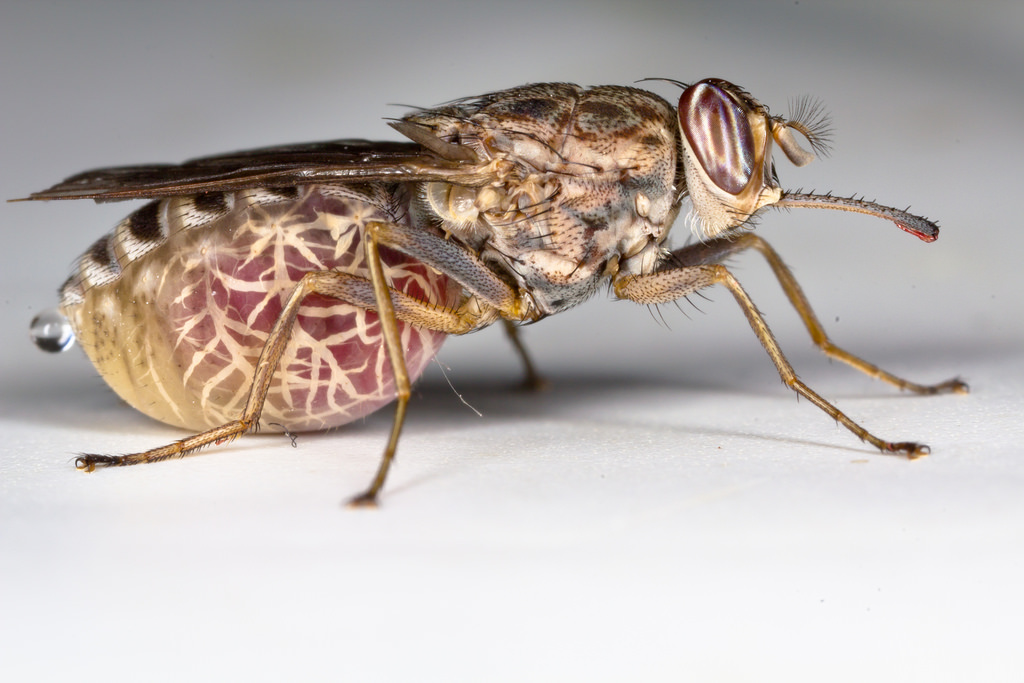IAEA, FAO project for Enhancing Vector Refractoriness to Trypanosome Infection
For the SIT to be successful, the sterile male insects that are released need to be competitive with wild males for matings with wild females.

Tsetse flies (Glossina spp.) are the only cyclical vectors of two debilitating diseases in sub-Saharan Africa, sleeping sickness in humans (human African trypanosomosis, HAT) and nagana in livestock (African animal trypanosomosis, AAT). Nagana, and in certain areas also sleeping sickness, has been a major obstacle to rural development in infested countries and a severe constraint to agricultural production.
Due to the absence of vaccines and effective, inexpensive drugs for the treatment of HAT, and the development of resistance of the AAT parasites to available trypanocidal drugs, vector control remains the most effective strategy for the sustainable management of these diseases.
The many successes of area-wide programmes integrating the Sterile Insect Technique (SIT) with other control tactics against screwworm flies, fruit flies, moths and the removal of a Glossina austeni population from the Island of Unguja, Zanzibar encouraged several African countries to consider the use of this technology for the creation of tsetse-free zones in their territories. The SIT relies on the mass-rearing of high-quality sterile male insects that are then released in target areas where they will mate with the wild virgin females.
Such matings result in no offspring and sequential releases will result in a decline of the wild population. For the SIT to be successful, the sterile male insects that are released need to be competitive with wild males for matings with wild females, but their production in large numbers needs also to be cost-effective.
At the heart of the SIT technology is the use of ionising radiation to sterilize the very large numbers of mass-reared male insects prior to their release. Unlike fruit flies or mosquitoes, tsetse males feed on blood and can transmit the trypanosome parasites, which represent a risk for humans during the implementation of SIT programmes.
Releasing males of a tsetse strain that are refractory to the transmission of the parasites would therefore be extremely advantageous.
In that respect, the IAEA, in cooperation with the Food and Agriculture Organization of the United Nations (FAO), has now completed a coordinated research project (CRP), D42015, on Enhancing Vector Refractoriness to Trypanosome Infection. This study involved 23 scientists from 19 countries and resulted in the following key achievements and findings:
- The full genome sequence of 6 tsetse species was completed.
- Spiroplasma bacteria were identified in some tsetse species for the first time.
- Infection of tsetse species with small iflaviruses was discovered for first time.
- The effects of sterilizing radiation on the microbiota and the cuticular hydrocarbon profile were documented and a new protocol to maintain tsetse symbionts in irradiated males developed.
- New bacteria that block trypanosome infection is tsetse flies were identified.
- Procedures associated with the development of paratransgenic tsetse lines have been optimized.
- Ten PhD students completed their degrees in CRP related subjects.
The research conducted during this project pioneered the study of symbiotic bacteria and pathogens associated with tsetse flies. It therefore has high relevance to the further improvement of the SIT against these pest insects.
During the implementation of this CRP novel information on the role of symbiotic and gut bacteria of tsetse flies in blocking trypanosome infection and in affecting tsetse mass-rearing was obtained. In addition, the impact of ionizing radiation on tsetse microbiota was evaluated with the aim to assess the possibility to use paratransgenesis to develop stable tsetse fly lines refractory to trypanosome infection.
One of the important findings of this CRP was the feasibility of introducing modified bacteria into tsetse flies leading to stable establishment of the bacteria and effective trans-generational transmission. The results indicate that injecting the modified bacteria during the larval stage is the only successful way to ensure trans-generational transmission of the bacteria in tsetse flies (Fig. 2).
The research carried out in this CRP generated 160 scientific publications in peer-reviewed journals, numerous presentations in international and national scientific meetings, and ten PhDs written by graduate students. The final CRP results will shortly be published in BMC Microbiology Special Issue and will comprise at least 23 publications. Outcomes of this study are now being validated for use in operational tsetse SIT programmes.
- READ MORE ON:
- Tsetse flies
- IAEA and FAO
- African trypanosomosis
- animal trypanosomosis










